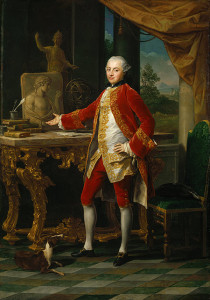CLASS: BONE DEEP GOTHIC
Curious what this is all about? Find out here!

One very reasonable question at this point is “why Salvator Rosa?”
After all, we have taken a look at Rosa in light of when and where he lived, and we have seen that, in that context, his work was not viewed, by himself or others, as “gothic.” Indeed, the word “gothic” did not exist at that time except as a description of the Germanic tribes of a thousand years prior.
The answer, argued by Davenport-Hines and other historians of the genre, is that a proto-Romantic British interpretations of Rosa’s art as sublime, wild, and subversive became the dominant aesthetic around which early concepts of the gothic coalesced. As English critic John Ruskin wrote 1843:
[Rosa] saw only what was gross and terrible, — the jagged peak, the splintered tree, the flowerless bank of grass, and wandering weed, prickly and pale. His temper confirmed itself in evil, and became more and more fierce and morose; though not, I believe, cruel, ungenerous, or lascivious. I should not suspect Salvator of wantonly inflicting pain. His constantly painting it does not prove he delighted in it; he felt the horror of it, and in that horror, fascination.
Lord Edward Bulwer-Lytton, the man who gave us “it was a dark and stormy night,” wrote about Rosa in his occult 1842 novel Zanoni:
[Rosa’s] images have the majesty, not of the god, but the savage; utterly free, like the sublimer schools, from the common-place of imitation,—apart, with them, from the conventional littleness of the Real,—he grasps the imagination, and compels it to follow him, not to the heaven, but through all that is most wild and fantastic upon earth; a sorcery, not of the starry margin, but of the gloomy wizard…
Another critic, Anthony Ashley Cooper, 3rd Earl of Shaftesbury, who was part of the first generation to participate in a series of European “Grand Tours,” was so struck by the sublimity of his experiences, that he was to have a deathbed portrait of himself painted with Mount Vesuvius visible through a window. Shaftesbury collected paintings by Rosa, describing “those wild savage figures of banditti, wandering gypsies, strollers, vagabonds, etc., at which he was so excellent,” and “rock in the most stupendous manner… majestic, terribly impending, vast, enormous as it should be.”
And Horace Walpole, the first gothic novelist de jure, wrote succinctly of the French Alps: “precipices, mountains, torrents, wolves, rumblings, Salvator Rosa.”
It is not insignificant that these retrospective opinions all come from British connoisseurs, nor that after his death, most of Rosa’s work found its most successful market with British collectors. His landscapes also resonated with Enlightenment philosophers and promoters of the Sublime, who were, along with Rosa himself, extremely influential upon early gothic writers. Grand tourists of the 18th century — quite often the same collectors acquiring Rosa’s paintings and bringing them back to England — were captivated by the French Alps and Mediterranean classical ruin, and upon their return attempted to recreate these elements upon their own estates. This eventually became a feature of the national style, consiously and conspicuously opposed to the regimented geometry of the French estates of the ancien regime. Critic Margaret Jourdain was to later write that “the works of Salvator Rosa, with their savage scenery of rocks, cascades and blasted trees, opened English eyes to the picturesque qualities of the wilder kind of scenery.”
As the projected interpretation of and focused attention upon Rosa became a popular subject among the British educated classes, Rosa’s own life story was retold and reinterpreted to accommodate British sympathies. Thus Rosa’s renunciation of the priestly life and his Piarist mentors was interpreted as evidence of a fundamentally Protestant spirit. Stories circulated that Rosa was at times a banditti himself, or even member of a group of artist assassins that targeted members of the Spanish occupation. There is, of course, no evidence of truth to any of these rumors, but they do make a convincing argument for Rosa’s influence upon the first generations of bona fide gothicists. Poets had Homer and Milton, philosophers had Aristotle and Cicero, and the gothicists were to regard that Italian painter, Salvator Rosa, almost as their personal patriarch.
In upcoming entries, we will discuss British landscape gardening of the 18th century, itself deeply influenced by Rosa’s “picturesque” landscapes and advancing theories of the sublime. But first, we’ll pause to take a look at the real original Goths: the Germanic tribe that sacked Rome in the 5th century A.D. with guest blogger John Pendell.
Sources:
Lord Edward Bulwer-Lytton, Zanoni
Richard Davenport-Hines, Gothic
Helen Langdon, Salvator Rosa
John Ruskin, Modern Painters
